
Introduction
Digital to Analog converters (DACs) have been enjoying something of a renaissance in the past couple of years due to the widespread adoption of computer based music. Back before SACD, DVD-A and multichannel audio, DACs were the source component du jour for redbook CD. With the adoption of the new high-resolution formats, DACs fell out of favor, replaced by integrated universal disc players. Today, many people have gone to entirely computer based audio setups. The highest resolution digital audio available today does not come on a disc, but is available via download. This means DACs are back, and the Bryston BDA-1 is regarded as one of the best of the new breed of 24 bit 192 kHz DACs. Along with the Brytson BDA-1, we review the Halide Design USB to SPDIF Bridge.
Specifications
- BDA-1
- Design: DAC
- Decoding: 24 Bit, 192 kHz
- MFR: 20 Hz – 20 KHz, -0.1dB
- S/N: 140 dB Unweighted
- THD plus N: .002%
- Output Level – 2.3V Unbalanced – 4.6V Balanced
- Dimensions: 1.75″ H x 17″ W x 11.25″ D
- Weight: 12 Pounds
- MSRP: $2,150 USA
- Halide Design USB to SPDIF Bridge
- Design: Bridge Between USB and SPDIF
- Power: Supplied by USB Connection
- Built-In Power Rails for Digital Circuitry and Master Clock
- Supported Rates: 44.1, 48, 88.2, and 96 kHz (user selectable), at 24 bit resolution. (Note: Windows Vista / 7 currently requires WASAPI for non-resampled 88.2 kHz playback by plug-n-play USB audio products)
- Connection: 75 ohm, BNC or RCA
- Length – 6 Feet, 16 Feet Options
- MSRP: $450 USA
- Bryston Audio
My previous DAC was one of the first that handled digital signals like the BDA-1: reclocking with a FIFO (First In First Out) buffer and a high accuracy crystal oscillator to reduce jitter, upsampling and padding to higher bit depth and sample rate, combined with a state of the art, high bit depth and bit rate DAC. It is a Bel Canto DAC-1.1 and I’ve had it for almost 10 years. It was so good, I haven’t replaced it until now. The BDA-1 is the DAC that managed to finally send my old Bel Canto packing. I, like many others, was seduced by the siren song of the SACD and the DVD-A but recently found that computer based audio was they way to go. I now have all my music from redbook CDs and DVD-As stored on a hard drive in Apple Lossless format. I use an Apple Macbook Pro laptop as my music server. This means the DAC has become a much more important part of my music system: it is the high performance bridge between the mass-market computer and my audio system. For some time, I have been using the Bel Canto DAC with the optical digital output of the Macbook Pro. Unfortunately, this optical output is not very good. When I got the Bryston BDA-1, I also was able to get a hold of the Halide USB to SPDIF bridge. This in theory should be a much better way to connect the computer to the DAC than the Apple provided Toslink connection.
Is the reputation of the BDA-1 well deserved? Does the Halide Bridge sound as good as it should in theory? The short answer is yes. In this review, I’ll tell you why.
Design
Bryston is a Canadian company known for decades as a solid-state amplifier manufacturer offering a 20-year warranty on its amps. Bryston builds more than just amplifiers, offering a full range of amplifiers, preamplifiers and digital sources. The digital components get merely a 5-year warranty. The $2,150 BDA-1 has been in production for a couple of years, and is still a state of the art DAC. It is based on the Crystal Semiconductor CS-4398 24 bit 192 kHz DAC chips. This is Crystal’s best audio DAC and is widely regarded as one of the best DACs available. A Burr Brown SRC4392 sample rate converter pads 16 bit signals to 24 bit, and upsamples to 192 kHz for 32 kHz, 48 kHz and 96 kHz inputs, and to 176.4 kHz for 44.1 kHz and 88.2 kHz signals. This type of upconversion, converting to an integer multiple of the input signal, Bryson calls “synchronous,” although the sample rate converter still reclocks the input signal. Precision crystal oscillators running at 128x the maximum sample rates (one for 192 kHz and another for 176.4 kHz) are used to clock the sample rate converter. The loop bandwidth of the reclocking phase locked loop is 10 Hz, which should reject all jitter in the audio band. A button on the front panel allows the upsampling feature to be defeated if desired and feed the input signal directly to the CS-4398.
The BDA-1 has a vast array of inputs: 2 RCA, 2 BNC, 1 AES-EBU, 2 optical Toslink and one USB. The RCA, BNC and AES-EBU digital inputs have matching transformers to ensure the proper impedance (75 ohms for the RCA and BNC inputs, 110 ohms for the AES-EBU inputs). A Burr Brown PCM2707 chip, with a 48 kHz maximum sample rate, provides the USB input. There’s even a digital processor loop available. Front panel pushbuttons select digital inputs and LEDs above each pushbutton show which input is selected. An array of additional LEDs show the input sample rate and lock status. The LED above the upsample switch changes color based on upsampling to 192 kHz or 176.4 kHz. The only thing the front panel of the BDA-1 doesn’t tell you is the bit depth of the input signal.
The BDA-1’s analog outputs are entirely discrete (no op-amps), and are fully balanced. There are 4 complete Class-A output stages, each fed by one output of the two Crystal CS-4398 DACs, making the entire analog chain balanced from DAC to output. Both single ended RCA and balanced XLR outputs are provided, with the single ended outputs derived by summing the balanced analog output legs after the output stages.
The majority of the BDA-1’s circuitry is on a single circuit board at the rear of the case. This board takes up the full width of the case, but only about ½ the depth. The board contains the power supply, digital circuitry and the 4 discreet output chains. A second small board right behind the front panel contains all the switches and LEDs. A flex circuit connects the two boards across an expanse of empty case. The case could have been made half as deep, but that would have resulted in pretty funny looking proportions. I assume Bryston made the conscious decision to make the case larger than needed for aesthetic reasons.

Setup
Halide Audio USB to SPDIF Bridge
Very few DACs offer high performance USB inputs. Most USB audio interfaces are synchronous type interfaces, where a digital clock is synthesized on the computer to match the expected clock at the DAC. This technique results in lots of periodic jitter (an unfortunate side effect of digitally synthesized clocks). Another method, called “isosynchronous”, uses a synthesized clock on the computer, but adjusts the speed of this clock ~1000 times a second. This should reduce or eliminate low frequency jitter. The Burr Brown PCM2707 chip used in the BDA-1 uses this type of interface. Neither of these methods is really the right way to do things. A better way was developed over the course of several years by Gordon Rankin of Wavelength audio. His method is asynchronous, meaning there is no clock on the computer at all. The USB interface has precision crystal oscillators that clock the USB receiver, which request data from the computer at exactly the right time. He makes his own USB DACs with this technique, and has licensed the technology to several companies, including Ayre for their new USB DAC. Halide Audio is the first company to design a USB to SPDIF converter using the Wavelength interface. This allows you to gain the benefits of the Wavelength asynchronous USB transfer method with any DAC. The Halide Bridge is built right into the USB to digital audio cable. I tested a version with a BNC connector, but a RCA version is available. Behind the connector, a cylinder the same diameter as the connector and about 1.5 inches long contains all the electronics, including a transformer that electrically isolates the computer ground from the audio ground, and a pair of crystal oscillators, one for 44.1 and 88.2 kHz sample rates and another for 48 and 96 kHz sample rates. The bridge works up to 96 kHz and requires no special drivers for either Windows or OSX. The bridge pads all input signals to 24 bit. Halide sells the bridge manufacturer-direct for $450, an especially good deal considering you need to buy no additional cables. I used the bridge with my 2006 vintage Macbook Pro 15″, with OSX 10.6 and iTunes 10. Music was stored in Apple Lossless format on a remotely located hard drive accessed over a wireless network (what Apple calls Airdisk). I used my iPhone as a remote with Apple’s “Remote” application. My bridge worked perfectly with absolutely no software configuration necessary.

In Use
The BDA-1 is the first DAC I have heard in my system that really made a significant improvement over my trusty Bel Canto DAC-1.1, without costing an arm and a leg. While $2,150 is not exactly cheap, the BDA-1 offers a lot of performance and a lot of features for the money. It is fully balanced with discrete analog output stages, uses the latest and best available sample rate converter and DAC chips, has a wealth of digital inputs and more. I first tried the BDA-1 using the Toslink output from the Macbook Pro as I had with the DAC-1. This combination resulted in virtually every area of the performance of my system improving. In particular, the soundstage was significantly wider, images sharper and extraction of detail was improved. The dynamics were similar, but when combined with the improved detail, soundstaging and imaging, the system sounded a little flat. This was most obvious with highly produced pop recordings with a lot of compression. A good example is Daft Punk’s Human After All, which should fill the room with a level of bass power and impact that is shocking. With both the DAC-1.1 and the BDA-1 with the Toslink input, the dynamics and impact were dulled a bit.
When I received the Halide Bridge, the sound took a significant change for the better. This wasn’t entirely expected, since the BDA-1 rejects all jitter faster than 10 or 20 Hz, but the change in the sound was undeniable. The dynamic flatness with the Toslink input was gone, while the improved soundstaging, imaging and detail retrieval was preserved. The combination of the Halide Bridge and the BDA-1 was the real ticket. The pair of components managed to improve on every aspect of sound compared to the Bel Canto.
After getting the Halide Bridge in the system, I didn’t go back to other inputs. All my music is now delivered to my system through computer, with the exception of SACD and that doesn’t go through the DAC. My favorite improvement delivered by the BDA-1 was the significant increase in space. The wider soundstage, located a foot or two farther back compared to the Bel Canto made all recordings sound bigger and more spacious. There was also a significant improvement in the ability to hear detail. By comparison, the Bel Canto began to sound muddled and confused in louder, more complicated passages. The BDA-1 retained its ability to present clear detail even when the recording was busy. An example was the album “Dedicated to Diz” by Slide Hamption and the Jazz Masters. This modern big band jazz recording has a combination of soloists playing on their own with minimal backup, and the whole band laying it down. With the Bel Canto, soloists sounded fantastic, with every last nuance audible, but when the rest of the band came in, I could not listen to each instrument with the same precision. The BDA-1 also sounded great with the soloists, but maintained that ability to hear detail even with the whole ensemble going full speed.
Throughout my auditioning, I left upsampling on most of the time. I tried turning upsampling off with both 16-44.1 and 24-96 source material, and didn’t really hear much difference. The upsampling (especially the way Bryston implements it) should only help, so I left it on.
On the Bench
Measurements were made with my new M-Audio Profire 610 Firewire audio interface with Spectra Plus FFT analysis software. The coaxial SPDIF output of the Profire 610 was used to drive the BDA-1 for some tests, and the Halide Bridge for others. The frequency response of the Profire 610 was measured and corrected for using a loopback test (output directly connected to input). All the plots are scaled to 0 dB Full Scale (dBFS) This means 0 dB on the plots is the maximum digital output level, with all 16 or 24 bits set to 1. I have no jitter analysis equipment, so I was unable to measure the jitter spectrum of the Halide Bridge directly.
Total harmonic distortion plus noise (THD+N) was measured using a 0 dBFS 1 kHz tone. Measurements were made at 16 bits 44.1 kHz, 24 bit 96 kHz and 24 bit 192 kHz, both with and without the SPDIF bridge driving the BDA-1.
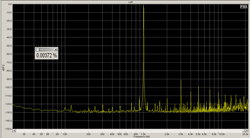
At 16 bit, 44.1 kHz driven by the Profire 610, the THD+N is a very low 0.0037%, which is near the noise floor of the measurement system and fully consistent with the 0.002% THD+N quoted by Bryston. The push pull analog output stage of the BDA-1 yields odd order harmonics all lower than 90 dB down, but visible out to past the 11th harmonic.
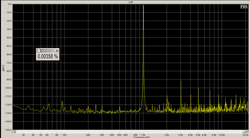
The same test done with the SPDIF bridge shows a slightly lower THD+N measurement (0.0002% less) and a very slightly cleaner distortion spectrum.
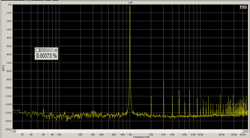

At 96 kHz the spectra are similar, but cleaner. Driven by the Profire the THD+N is 0.0037% (top) and driven by the Halide Bridge the THD+N is 0.0028% (bottom).
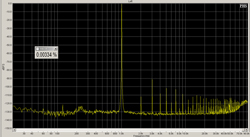
At 192 kHz, the measurement was made only with the Profire as the digital source since the Halide Bridge tops out at 96 kHz. THD+N is 0.0034%.
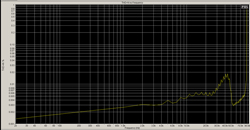
THD+N vs frequency was measured with a 24 bit 192 kHz signal from 20 Hz to 96 kHz. The result was extremely low across the board. The bump at 40 kHz is an artifact of the measurement setup. The sharp rise near 96 kHz is due to the anti-aliasing filter roll-off.
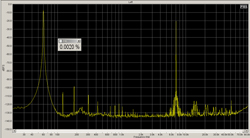
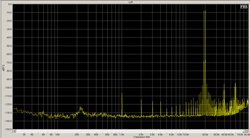
Intermodulation distortion was measured at 24 bit 192 kHz with a pair of tones at 60 Hz and 7 kHz. IMD was a spectacularly low 0.002% (top). Another test was made with a 19 kHz and a 20 kHz tone. The 1 kHz intermodulation product was about 100 dB down from the test tones (bottom).
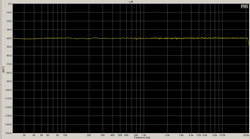

Frequency response was measured at 16 bit 44.1 kHz (top) and 24 bit 192 kHz (bottom). Deviation from flat is very small, and is most likely due to imperfect correction of the measurement setup’s frequency response. The anti-aliasing filter at the higher sample rate is much more gentle than the lower sample rate, starting to roll off at 48 kHz.
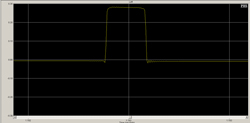
Time domain response was measured at 24 bit, 192 kHz with a 10 kHz square wave. Very little ringing and round off of the square wave is evident.
Conclusions
The combination of the Bryston BDA-1 and the Halide Audio USB to SPDIF bridge is something very special. It was good enough that I replaced a DAC I had loved for almost 10 years. They made everything sound better, across the board, and did so with enormous flexibility and at a reasonable cost. I can’t recommend the BDA-1 more highly for anyone who wants the highest performing DAC they can get without paying a huge amount of money. The measured performance is impeccable. If you also use a computer as a source and want to connect a DAC via USB, the Halide Bridge is a no brainer. It is the right way to do the job. Pretty much everything else (excepting Wavelength’s more expensive 192 kHz bridge) is the wrong way. There was absolutely no question I would buy both at the end of the review period, and that’s what I did.


